The Edward Clark Collection covers the history and development of printing in western Europe together with some American developments. The oldest item in the collection is a leaf from the 42-line Bible printed in Mainz by Johannes Gutenberg between 1455.
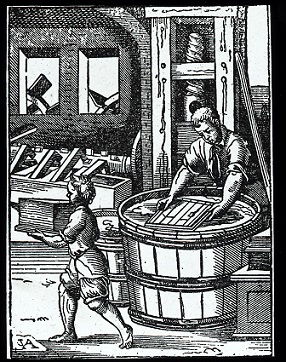
By Gutenberg’s time, the techniques of papermaking and printing from wood blocks had been known in China for over 1,000 years and a form of movable type had been in use for around 200 years.
The first paper mill in Europe dates from the 12th century: the techniques were introduced to Spain by the Moors.
1455 The first known book printed by movable type in Western Europe, the Biblia latina (known as the 42-line Bible), is completed in Mainz at the press of Johannes Gutenberg.

1460s Earliest use of Roman type by Arnold Pannartz and Conrad Sweinheim, the first printers in Italy at Rome/Subiaco; and of Greek type by Johannes Fust and Peter Schöffer (Cicero De officiis)
1476 William Caxton sets up his press at Westminster: the first dated book from this press was Dictes or sayengis of the philosophres in 1477
1477 Intaglio engraving is first used for book illustration
1493 Anton Koberger prints Liber Chronicarum, also known as Die Weltchronik and The Nuremberg Chronicle It is one of the first successful attempts to integrate text and illustration

1499 Aldus Manutius prints Hypnerotomachia Poliphili in Venice
1501 Aldus Manutius first uses italic type in his editions of Virgil and Juvenal. These small format books for personal use were another innovation: another example is his edition of Lucan’s Pharsalia, 1502
1508 Walter Chepman and Andro Myllar print The Complaint of the Black Knight, the first dated book in Scotland
1515 Technique of etching is developed in Augsburg by Daniel Hopfer
1530 Roman typeface is designed in Paris by Claude Garamond
1545 Garamond establishes his typefoundry in Paris, the first to be independent of a printing office
1568-1573 Christoph Plantin prints his 8-volume Bible regia in 5 languages, known as the Polyglot Bible in Antwerp
1576 Thomas Bassandyne and Alexander Arbuthnot are the first printers of the Bible and Holy Scriptures in Scotland: this is the so-called Geneva version
1578-89 Robert Granjon cut a series of types for the Typographia Vaticana in Rome

1583 Christoph Plantin prints Biblia Sacra in Antwerp. It has an engraved title page and with copperplate illustrations throughout
1584 Cambridge University Press is established
1586 Oxford University Press is established by decree of the Star Chamber
1611 The ‘Authorized Version’ of the King James’ Bible is first published

1622-1649 Edward Raban printing in Aberdeen for the town and university
1623 Publication of the first folio edition of Shakespeare’s plays: the second folio edition was published in 1632
1655 The London Gazette (originally called the Oxford Gazette) is first published: it claims to be the oldest regularly published newspaper in the United Kingdom

1669 Dr John Fell begins working to improve the standard of printing at Oxford University Press. He bought new type from Holland and invited the punch-cutter Peter de Walpergen to move to Oxford. The types collected are known as the ‘Fell types’
1683 Joseph Moxon’s Mechanick Exercises on the Whole Art of Printing is published – first printed manual for printers
1710 Copyright legislation covering the whole United Kingdom is passed
1720 William Caslon establishes his typefoundry in London
1725 Jacob Christoph Le Blon describes three colour (red, yellow, blue) printing process in Coloritto. In 1735 he patented a four-colour process

1727 William Ged of Edinburgh develops a process of stereotyping (known as ‘block printing’ using plaster of Paris moulds
1737 Pierre-Simon Fournier first proposes a standardised measurement for type called the ‘typographical point’
1740s-1770s Robert and Andrew Foulis print fine editions of the classics and other works in Glasgow as University Printers. After their deaths the business was carried on by Robert’s son Andrew until 1795

1751/2 John Baskerville establishes his printing business in Birmingham, for which he designed the type. He was supplied with paper for printing by James Whatman
1755 Publication of Samuel Johnson’s Dictionary of the English Language
1757 Didot family typefoundry is established
1763 Baskerville prints the Holy Bible for Cambridge University Press using type of his own design
1764 Pierre-Simon Fournier publishes Manuel typographique
1768-71 First (Edinburgh) edition of the Encyclopaedia Britannica is edited and printed by William Smellie
1771 Giambattista Bodoni publishes his first type-specimen book: his Manuale tipografico was published in 1788

1775 Thomas Bewick develops technique of wood-engraving: A general history of quadrupeds was published in 1784 and History of British birds in 2 volumes in 1797
1775 François-Ambroise Didot establishes the ‘Didot’ point for measuring type, superseding the ‘Fournier point’
1792 Vincent Figgins establishes his typefoundry in London
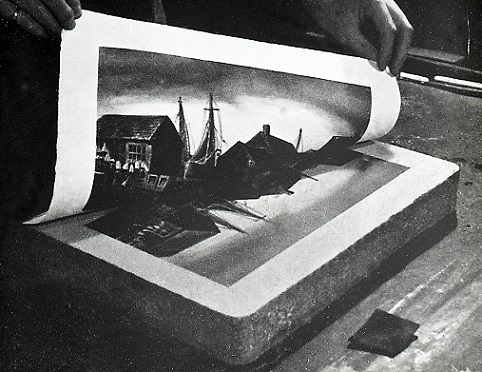
1796 Aloysius Senefelder develops an entirely new printing technique of lithography or ‘printing from the stone’, which relies on the repulsion between the water used to treat the limestone carrying the image to be printed, and the oil in the ink
1790 Giambattista Bodoni designs a modern Roman typeface
1800 The first all-iron press, still using a screw to apply pressure on the platen, is designed by Earl Stanhope. The size of the platen was doubled, and a system of levers meant that the

1806 Bryan Donkin, and brothers Henry and Sealy Fourdrinier perfect the design of a papermaking machine that produced a continuous roll (or ‘web’) of paper
1806 Hansard’s Debates, recording parliamentary proceedings, is first published by the Printer to the House of Commons, Luke Hansard
1810 Friedrich Koenig’s steam-powered platen press is patented. It was first used in April 1810 by Thomas Bensley to print the New Annual Register for 1811


1812 Early hand-operated cylinder press developed
1813 George Clymer invents the iron ‘Columbian’ printing press (in Philadelphia), which used linked levers to apply pressure to the platen
1814 Friedrich Koenig & Andreas Bauer install first steam-powered cylinder printing press for John Walter II at The Times. The impression is produced by passing a cylinder over the paper instead of using a flat platen
1816 William Caslon IV designed a sans-serif typeface though it is not clear if it was ever used in printing
1818 Stephenson Blake typefoundry established in Sheffield by James Blake, John Stephenson and William Garnett. The firm went by various names, becoming Stephenson, Blake & Co in 1841

1822 The iron ‘Albion’ press is invented by R W Cope in London; William Church patented a machine for composing type though it was never used commercially
1825 Thomas Hansard’s Typographia: an historical sketch of the origin and progress of the art of printing is published
1826 The London General Trade Society of Compositors is established: it became the London Society of Compositors in 1848
1829 Louis Braille published his system of raised dots for printing text for blind readers
1830 Calendared paper (given a smooth finished by being passed through steel rollers) is first produced

1835 Bookbinders’ Consolidated Relief Fund is founded to support tramping members, becoming the Bookbinders’ Consolidated Union in 1840, and changing the name to the Bookbinders and Machine Rulers’ Consolidated Union in 1872. In 1911 it amalgamated with a number of other societies to become the National Union of Bookbinders and Machine Rulers
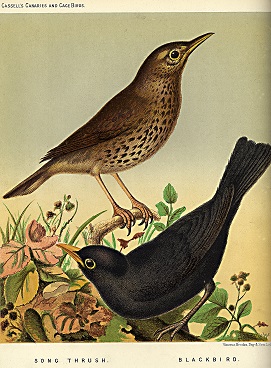
1837 Gottfried Engelmann patents technique of chromolithography in France, for producing coloured illustrations
1838 Electrotyping process is discovered by Moritz von Jacobi, a Prussian working in St Petersburg: it is a chemical process for creating metal printing plates
1838 David Bruce II invents a typecasting machine. His father, David Bruce I, emigrated from Scotland and set up the first commercial typefoundry in America
1839 William Fox Talbot publishes his treatise on photography
1840 James Hadden Young and Adrien Delcambre build a ‘Pianotype’ machine for composing type: it is often referred to as the Young-Delcambre machine

1843 Process for making paper from wood pulp is patented in Germany by Friedrich Keller of Saxony, although commercial production did not take place for some years
1845 Richard March Hoe of New York builds a rotary machine for letterpress printing: the type is fixed to a cylinder instead of being held in a flat bed. In 1848 Augustus Applegath built a type-revolving printing machine for The Times
1848 Provincial Typographical Association (later the Typographical Association) established
1850 Andreas Hamm founds Schnellpressenfabrik of Heidelberg, later known as Heidelberger Druckmaschinen AG
1851 Thomas Nelson II’s reel-fed rotary printing press is exhibited at the Great Exhibition
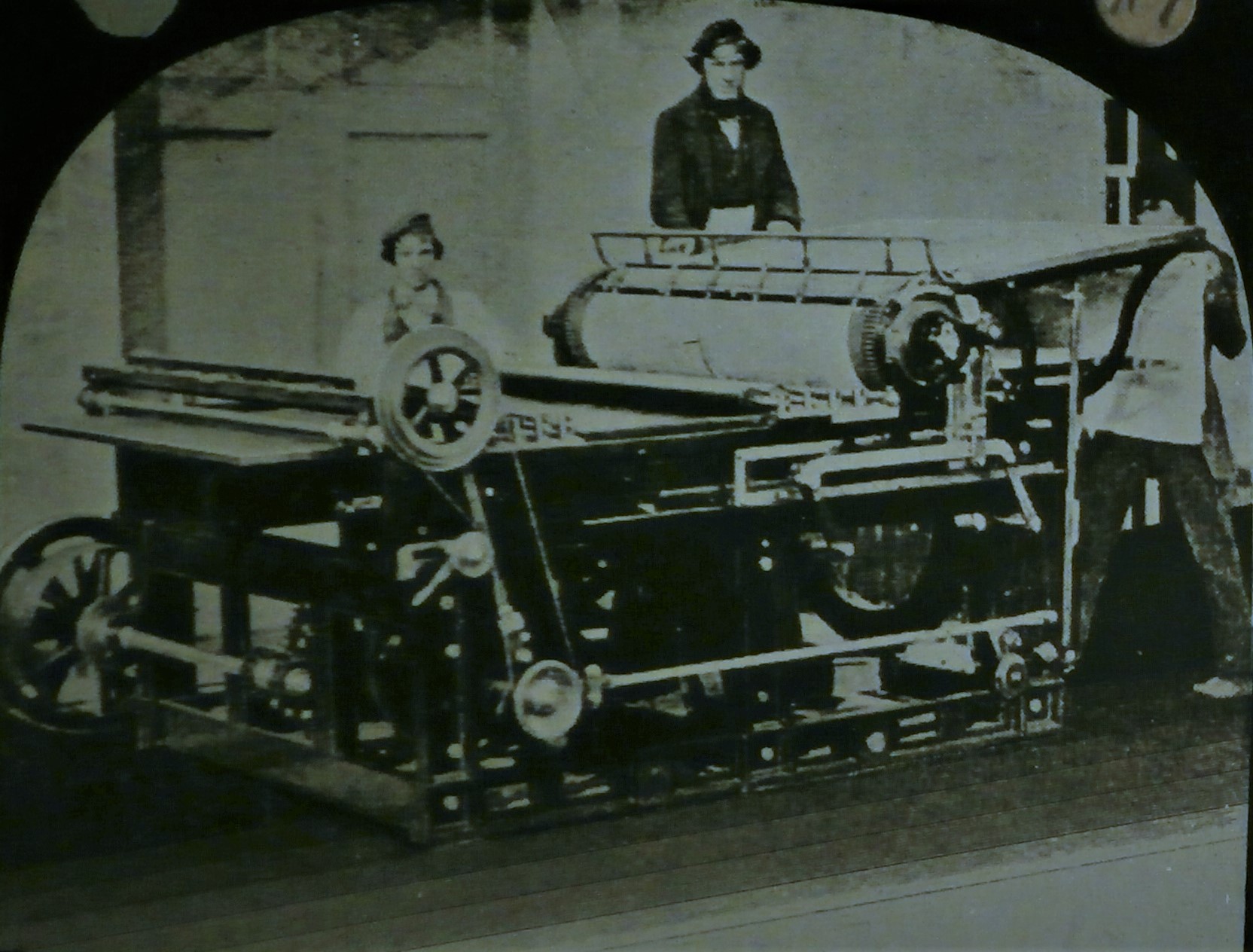
1853 Scottish Typographical Association established
1855 The first flat-bed stop-cylinder printing machine was produced by William Dawson in Otley in Wharfedale in Yorkshire. This design became known as a ‘Wharfedale’
1859 Robert Hattersley invents a composing machine, which went into use in some newspaper printing offices
1860 The Central Association of Lithographic and Copperplate Printers’ Societies of Great Britain and Ireland is formed. This Association formed the main part of the new Amalgamated Society of Lithographic Printers when it was formed in 1880
1863 James Dellagana invents a casting box for curved stereotype plates, which can be fitted to rotary presses
1872 Karl Kastenbein’s composing machine came into use in The Times printing office. The machines continued in use until 1908
1870s Collotype or photogelatin printing comes into general use
1876 Plantin-Moretus Museum established (Antwerp)
1880 Joseph Thorne builds a prototype of his typesetting machine; the Amalgamated Society of Lithographic Printers is established: the Printers’ International Specimen Exchange is first published
1881 Chandler & Price established in Cleveland, Ohio
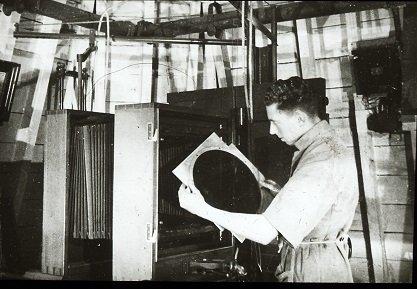
1882 Georg Meisenbach patents his half-tone method: the original image is broken down into equally spaced dots, which vary in size according to the depth of tone in the original, by being photographed through a ruled screen, and the negative transferred to a zinc plate to be developed and etched

1885 The National Society of Lithographic Artists, Designers and Writers, Copperplate and Wood Engravers is formed: after a number of name changes it became the Society of Lithographic Artists, Designers, Engravers and Process Workers, usually referred to as SLADE, in 1922. It amalgamated with the National Graphical Association in 1982
1886 Ottmar Mergenthaler’s Linotype, the first successful hot-metal typesetting machine, is first used in the New York Tribune; the Berne Convention for Protection of Literary and Artistic Works establishes international recognition of copyright

1887 Tolbert Lanston of Philadelphia patents the Monotype ‘hot metal’ system – the keyboard and caster are separate machines and individual types are cast as required
1889 Printers’ Labourers Union is formed. It was renamed the Operative Printers’ Assistants’ Society 10 years later; the National Society of Operative Printers’ Assistants in 1904; and the National Society of Operative Printers and Assistants in 1912. It was almost always referred to as ‘NATSOPA’
1891 Kelmscott Press (active until 1899) is founded by William Morris: his edition of Chaucer’s works is one of the press’s most famous publications
1891 The St Bride Foundation and printing school is established just off Fleet Street in London
1893 The Doves Bindery is set up by Thomas James Cobden-Sanderson
1895 Ashendene Press established in Chelsea by C H StJ Hornby. It closed in 1935

1900 The Doves Press is founded by T J Cobden-Sanderson and Emery Walker: its most significant publication was the Bible in 5 volumes. The partnership was dissolved in 1908 and a dispute over the ownership of the type followed. Cobden-Sanderson threw the matrices into the River Thames at Hammersmith Bridge in 1913. He threw the type itself into the river at the same point between August 1916 and January 1917
1905 Commercial offset printing machines for lithographic printing on paper are developed: offset lithography took over from letterpress as the main process for printing text in the 2nd half of the 20th century
1906 Ludlow Typograph Company founded in Chicago – the current semi-mechanical Ludlow typecasting machine was introduced in 1911
1909 Vandercook and Sons, makers of flatbed cylinder proofing press is established in Chicago
1923 Stanley Morison is appointed as typographical advisor to Cambridge University Press, and to the Monotype Corporation. He also advised the Times, which commissioned him to design the Times New Roman typeface, in use from 1932
1925-28 Eric Gill designs the Perpetua and Gill Sans typefaces
1930s Introduction of polyurethane rollers for printing machines
1953 Lumitype phototypesetting machines (where the letters to be printed are projected onto film for offset printing) is first used for book-work; it was first used to newspaper production in 1954
1950s Photopolymer relief printing plates are introduced
1951 The first DRUPA printing equipment exhibition is held in Düsseldorf
1957 Dye sublimation; Helvetica typeface; image scanner (76 pixels) introduced; 1st photopolymer-based letterpress plate
1958 Xerography (photocopying) comes into commercial use
1963 Pantone Matching System Printers’ Edition is introduced
1980s Desktop publishing software becomes widely available, allowing typesetting, page design and make-up to be separated from the printing process: the PostScript typesetting language was also introduced and this period. Pagemaker, QuarkXPress and Adobe Photoshop followed
1993 First digital colour printing press launched
2014 Some of the Doves type matrices & punches are rescued from the Thames
